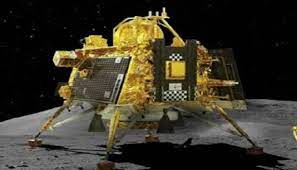
India’s space agency, the Indian Space Research Organisation (ISRO), is on the brink of achieving a monumental feat as Chandrayaan-3 gears up to make a soft landing on the moon’s surface with the Vikram Lander carrying the Pragyaan rover nestled within it. The final moments of this ambitious mission, referred to as the “20 Minutes of Terror,” are set to capture the nation’s attention.
After a flawless lift-off, ISRO’s Mark-3 launch vehicle propelled Chandrayaan-3 into orbit. The spacecraft underwent a series of elliptical orbits around the Earth to gain the necessary velocity for its lunar journey. On August 1, Chandrayaan-3 embarked on its 384,000-kilometer journey to the moon, ultimately entering the lunar orbit on August 5. The satellite was then meticulously stabilized for several days to prepare for the upcoming critical maneuver.
In a meticulously orchestrated maneuver on August 17, the propulsion module separated from the Vikram lander and Pragyaan rover, while the satellite was positioned in a 153 km by 163 km orbit. The propulsion module continued its independent journey in lunar orbit, while the Vikram lander underwent a series of trajectory adjustments to position it for the powered descent phase. This process mirrors the success of Chandrayaan-2’s similar maneuvers.
The 20 minutes of intense anticipation come to a head on the day of the planned landing. Following commands from ISRO’s headquarters in Bengaluru, the Vikram lander initiates its descent from an altitude of 25 kilometers. This powered descent commences with the lander hurtling towards the lunar surface at a breathtaking velocity of 1.68 kilometers per second, nearly 10 times the speed of an airplane.
As the lander nears its target, a phase known as the “rough braking phase” begins, during which the lander slows down while maintaining its almost horizontal orientation to the lunar surface. This phase lasts approximately 11 minutes and is followed by a meticulous series of maneuvers to position the lander vertically for the “fine braking phase.” It was during this delicate phase in Chandrayaan-2’s mission that the Vikram lander lost control and tragically crashed.
At an altitude of 800 meters, both horizontal and vertical velocities halt, and the Vikram lander hovers just above the moon’s surface to survey the landing site. Progressing further, the lander halts at 150 meters, capturing images to assess hazards and determine the optimal landing location. With a carefully calculated touchdown, utilizing just two engines firing, the lander’s legs designed to endure an impact of up to 3 meters per second come into play.
Upon sensing contact with the lunar surface, the engines cease operation, marking the end of the heart-pounding 20 minutes of terror. The subsequent settling of lunar dust, known as regolith, signals the opening of the lander’s ramp, allowing the Pragyaan Rover to gradually descend. Once safely on the moon’s surface, the rover embarks on its mission, capturing images of the lander while it captures images of the rover—an historic exchange that culminates in India’s first lunar selfies.
The Vikram lander and Pragyaan rover are both equipped with solar panels and designed to function throughout one lunar day, equivalent to 14 Earth days. Should all go as planned, India will join an elite group of countries to successfully execute a soft landing on the moon. As the nation awaits the outcome of this daring venture, the spirit of exploration and scientific advancement stands as a testament to India’s prowess in space exploration.
Sources By Agencies


